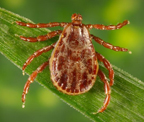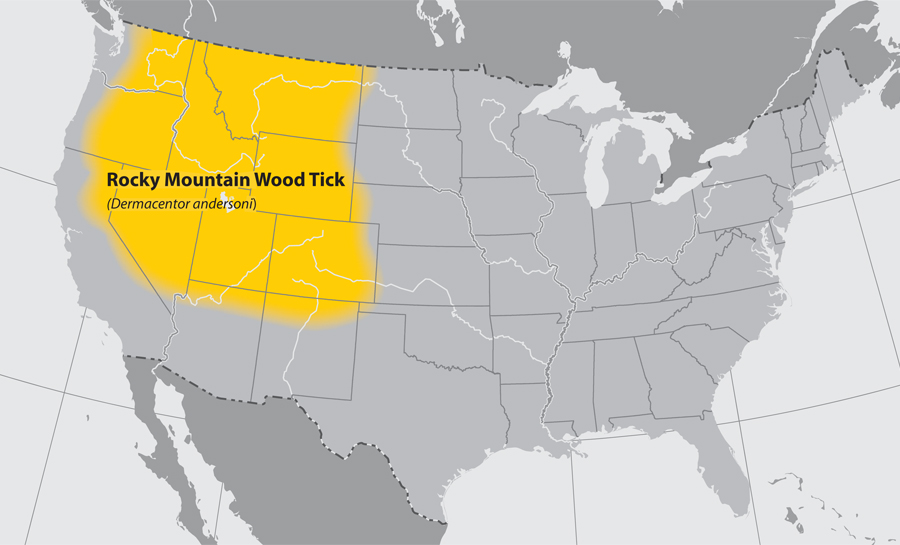Dermacentor andersoni: Difference between revisions
Jump to navigation
Jump to search
No edit summary |
No edit summary |
||
| Line 49: | Line 49: | ||
*Once feeding is completed, the tick will seek a new host and transfer any pathogens during the next feeding process. <ref name="LCT CDC”">Life Cycle of Ticks that Bite Humans (2015). http://www.cdc.gov/ticks/life_cycle_and_hosts.html Accessed on December 30, 2015</ref> | *Once feeding is completed, the tick will seek a new host and transfer any pathogens during the next feeding process. <ref name="LCT CDC”">Life Cycle of Ticks that Bite Humans (2015). http://www.cdc.gov/ticks/life_cycle_and_hosts.html Accessed on December 30, 2015</ref> | ||
==Key features== | |||
== | |||
* The larva only has three pairs of legs. | * The larva only has three pairs of legs. | ||
* The nymph has four pairs. | * The nymph has four pairs. | ||
| Line 64: | Line 59: | ||
* The posterior margin of opisthosoma is usually subdivided into sclerites called festoons. | * The posterior margin of opisthosoma is usually subdivided into sclerites called festoons. | ||
* The pedipalps are rigid along the chelicerae, and are not leg-like. | * The pedipalps are rigid along the chelicerae, and are not leg-like. | ||
==''Dermacentor andersoni'' Transmitted Diseases== | |||
The Rocky Mountain wood tick is known to transmit the following tick-borne diseases: | |||
*[[Rocky Mountain spotted fever]] | |||
*[[Colorado tick fever]] | |||
*[[Tularemia]] | |||
==Geographic Distribution== | |||
[[Image: Rocky mountain wood tick.jpg| Center| 500px]] | |||
==References== | ==References== | ||
Revision as of 14:10, 18 February 2016
| style="background:#Template:Taxobox colour;"|Dermacentor andersoni | ||||||||||||||||||
|---|---|---|---|---|---|---|---|---|---|---|---|---|---|---|---|---|---|---|
 | ||||||||||||||||||
| style="background:#Template:Taxobox colour;" | Scientific classification | ||||||||||||||||||
| ||||||||||||||||||
| Binomial name | ||||||||||||||||||
| Dermacentor andersoni Stiles, 1908 | ||||||||||||||||||
| File:Dermacentor andersoni range map.svg |
Editor-In-Chief: C. Michael Gibson, M.S., M.D. [1]
Overview
Dermacentor andersoni, commonly known as the Rocky Mountain wood tick, is a species of tick.[1] It can cause tick paralysis.
Life Cycle
General Tick Life Cycle

- A tick's life cycle is composed of four stages: hatching (egg), nymph (six legged), nymph (eight legged), and an adult.
- Ticks require blood meal to survive through their life cycle.
- Hosts for tick blood meals include mammals, birds, reptiles, and amphibians. Ticks will most likely transfer between different hosts during the different stages of their life cycle.
- Humans are most often targeted during the nymph and adult stages of the life cycle.
- Life cycle is also dependent on seasonal variation.
- Ticks will go from eggs to larva during the summer months, infecting bird or rodent host during the larval stage.
- Larva will infect the host from the summer until the following spring, at which point they will progress into the nymph stage.
- During the nymph stage, a tick will most likely seek a mammal host (including humans).
- A nymph will remain with the selected host until the following fall at which point it will progress into an adult.
- As an adult, a tick will feed on a mammalian host. However unlike previous stages, ticks will prefer larger mammals over rodents.
- The average tick life cycle requires three years for completion.
- Different species will undergo certain variations within their individual life cycles. [2]
Spread of Tick-borne Disease
- Ticks require blood meals in order to progress through their life cycles.
- The average tick requires 10 minutes to 2 hours when preparing a blood meal.
- Once feeding, releases anesthetic properties into its host, via its saliva.
- A feeding tube enters the host followed by an adhesive-like substance, attaching the tick to the host during the blood meal.
- A tick will feed for several days, feeding on the host blood and ingesting the host's pathogens.
- Once feeding is completed, the tick will seek a new host and transfer any pathogens during the next feeding process. [2]
Key features
- The larva only has three pairs of legs.
- The nymph has four pairs.
- A single pair of spiracular openings (stigmata) are seen close to the coxae (leg bases or segments) of the fourth pair of legs (except in larvae).
- A terminal capitulum (mouthparts) is visible from above in all hatched stages.
- A large sclerite called the scutum is present dorsally behind the capitulum. The scutum almost entirely covers the back of the male, but only partly covers the back of the female.
- Eyes, if present, are on the scutum.
- Sexual dimorphism in size and colour is frequent. The female is often larger.
- The posterior margin of opisthosoma is usually subdivided into sclerites called festoons.
- The pedipalps are rigid along the chelicerae, and are not leg-like.
Dermacentor andersoni Transmitted Diseases
The Rocky Mountain wood tick is known to transmit the following tick-borne diseases:
Geographic Distribution
References
- ↑ Dergousoff SJ, Gajadhar AJ, Chilton NB (March 2009). "Prevalence of Rickettsia species in Canadian populations of Dermacentor andersoni and D. variabilis". Appl. Environ. Microbiol. 75 (6): 1786–9. doi:10.1128/AEM.02554-08. PMC 2655481. PMID 19151178.
- ↑ 2.0 2.1 Life Cycle of Ticks that Bite Humans (2015). http://www.cdc.gov/ticks/life_cycle_and_hosts.html Accessed on December 30, 2015
Gallery
- Common name: Rocky Mountain wood tick
- Scientific name: Dermacentor andersoni
- Reservoir: small rodents (larvae and nymphs); large mammals (adult ticks)
- Geographic distribution: Rocky Mountain states
- Disease transmitted: Rocky Mountain spotted fever, tularemia
-
Rocky Mountain wood tick (Dermacentor andersoni)
Adapted from CDC -
Approximate distribution of the Rocky Mountain Wood tick
Adapted from CDC
